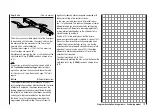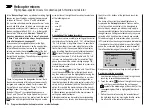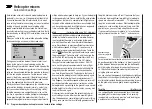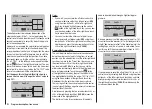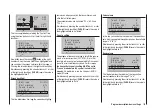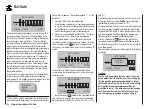
126
Program description: free mixers
General notes regarding freely programmable mixers
The two menus “
Fixed-wing mixers
” and “
Helicopter
mixers
”, as described on the preceding pages, contain
a wide range of ready-programmed coupling func-
tions. The basic meaning of mixers has already been
explained on page 108, together with the principle on
which they work. In the following section you will find
information relating to “free mixers”:
In addition to the pre-programmed mixers mentioned
above, the
mx-16
HoTT offers three freely program-
mable linear mixers which can be used in every model
memory; their inputs and outputs can be selected to suit
your exact requirements.
Any
control function
(1 to 8), or what is known as a
“switch channel” (see below), can be assigned as the
input signal
of a “free mixer”. The signal present at the
control channel, and passed to the mixer input, is deter-
mined by the transmitter control
and
any control charac-
teristics as defined, for example, in the “
D/R Expo
” and
“
Transmitter control settings
” menus.
The mixer output acts upon a
freely selectable control
channel
(1 to max. 8 - depending on receiver type).
Before the signal is passed to the associated servo, the
only influences which can act upon it are those defined
in the “
Servo settings
” menu, i. e. the servo reverse,
centre and travel functions.
One
control function
can be set up to affect several
mixer inputs simultaneously, if, for example, you wish to
arrange several mixers to operate in parallel.
Conversely it is possible for several mixer outputs to
affect one and the same
control channel
.
The following description of the free mixers includes
examples of such arrangements.
In software terms the default setting for any “free mixer”
is that it is constantly switched on, but it is also possible
to assign an optional ON / OFF switch to it. However,
since there are so many functions to which switches can
potentially be assigned, you should take care not to as-
sign dual functions to particular switches accidentally.
The two important mixer parameters are as follows:
… the
•
mixer ratio
, which defines the extent to which
the input signal acts on the output of the control
channel which is programmed as the mixer output.
… the
•
neutral point
, which is also termed the
“offset”. The offset is that point on the travel of a
transmitter control (stick, rotary proportional knob
CTRL 6 … 8 and SW 1 … 9) at which the mixer has
no influence on the control channel connected to its
output. Normally this is the centre point of the trans-
mitter control, but the offset can be placed at any
point on the control’s travel.
Switch channel “S” as mixer input
In some cases a constant control signal is all that is
required as the mixer output; a typical application would
be for slight up-elevator trim when an aero-tow coupling
is closed - completely independently of the normal
elevator trim.
If you then assign a switch, you can switch to and fro
between the two mixer end-points, and adjust the sup-
plementary elevator trim deflection by altering the mixer
ratio.
To identify this special arrangement, this mixer input
control function is designated “S” for “switch channel”
in the software. If you do not want the “target channel”
to be affected by the “normal” transmitter control, the
control can be de-coupled from the function input of
the associated control channel by entering “free” in the
“
Transmitter control settings
” menu; see pages 94
and 96. The following menu description again includes
an example which makes this function clear.
Now use the arrow buttons of the left or right-hand
touch-key to leaf through to the “
Free mixers
” menu
point of the multi-function menu:
mod. mem.
servo set.
D/R expo
wing mixer
base sett.
contr set.
phase trim
free mixer
servo disp
basic sett
fail-safe
telemetry
mod. mem.
servo set.
D/R expo
free mixer
base sett.
contr set.
heli mixer
swashp.mix
servo disp
basic sett
fail-safe
telemetry
Touch the central
SET
button of the right-hand touch-key
to open this menu point.
Summary of Contents for mx-12 Hott
Page 1: ...Programming Manual 33116 mx 16 HoTT 3 en mx 16...
Page 35: ...35 For your notes...
Page 49: ...49 For your notes...
Page 55: ...55 For your notes...
Page 59: ...59 For your notes...
Page 63: ...63 For your notes...
Page 69: ...69 For your notes...
Page 91: ...91 For your notes...
Page 101: ...101 For your notes...
Page 123: ...123 For your notes...
Page 181: ...181 For your notes...
Page 193: ...193 For your notes...


